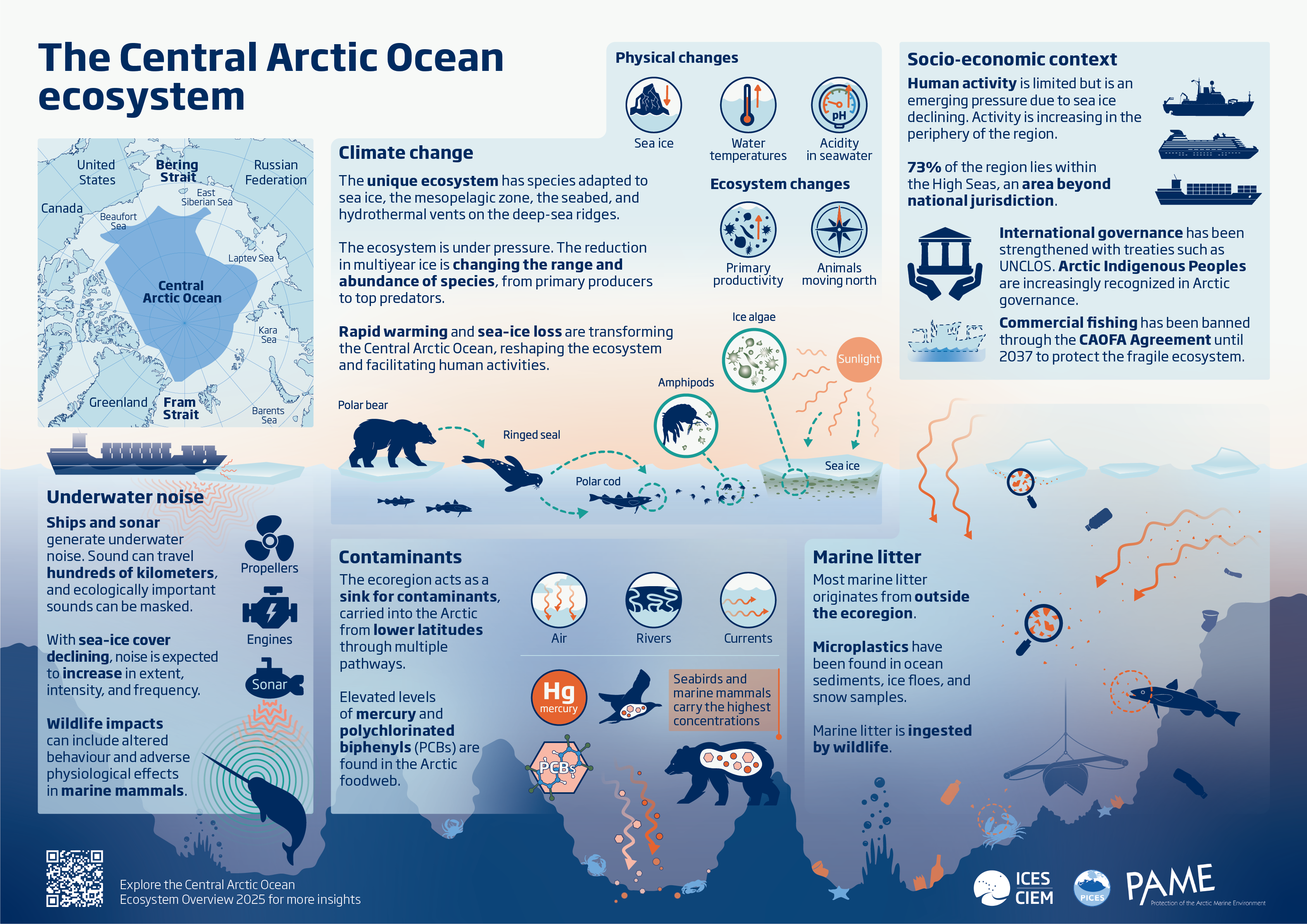The Central Arctic Ocean ecoregion mostly comprises high seas areas remote from any landmass, including deep basins and slopes up to depths of approximately 500 m, as well as some shallower shelf areas of the bordering Beaufort/Chukchi and East Siberian/Laptev seas. The boundary of the ecoregion follows the outer slopes on the Eurasian side from the Chukchi Sea to the Barents Sea, the shelf edge of north Greenland and the Canadian High Arctic, and runs along the 76°N parallel or the 200-mile Exclusive Economic Zones (EEZs) in the Beaufort/Chukchi seas.
The ecoregion is largely understudied. Thus, information from adjacent seas and nearby areas is used to inform the overview of this ecosystem.

Click image to view the infographic of the Central Arctic Ocean ecosystem
Key signals
Human activities and their pressure
- Few human activities occur in the Central Arctic Ocean (CAO). The ecoregion is a sink for contaminants and litter transported from global sources via ocean currents, rivers, and air.
- The most important pressure is the introduction of contaminants that bioaccumulate through the foodweb, leading to high concentrations primarily in ice-associated predators, such as seabirds.
- Sea-ice loss is creating opportunities for the development and expansion of human activities.
- Anthropogenic noise is expected to increase in intensity and frequency. Underwater noise is likely to have a higher impact in the Arctic compared to non-polar regions.
- The anticipated increase in the type and number of ships operating in the ecoregion will increase the risk of potential accidents, as well as emissions and discharges during routine operations.
State of the ecosystem
- Biota in the ecoregion is unique, with sea ice providing habitats for sympagic (ice-associated) species ranging from microbes to polar bears (Ursus maritimus). Multiyear sea ice supports more diverse communities of primary producers and consumers than first-year ice.
- Photosynthetic primary production is low and limited to the polar day.
- Hydrothermal vents on deep-sea ridges are important sources of localized chemosynthetic primary production and benthic biomass.
- Soft-bottom benthic biomass in CAO deep-sea basins is low compared to other ecoregions.
- The zooplankton community is diverse, with large copepods Calanus spp. comprising most of the biomass. Ice-associated amphipods are important components of the foodweb.
- The estimated fish biomass is low, below levels that can sustain a viable fishery.
Climate change
- Climate change is the dominant and overarching driver in the ecoregion.
- A reduction in the extent and thickness of the sea ice is the prevailing climate change signal. Other observed climate-related effects include increases in seawater temperature and acidification, changes in salinity and freshwater content affecting water column stratification, and changes in relative contributions of North Atlantic and North Pacific water masses.
- Receding sea ice, and the reduction in multiyear ice, has led to changes in both the range and abundance of species from primary producers to top predators. Examples include an increase in phytoplankton biomass, a reduction in the diversity and biomass of ice-associated algae and amphipods, and the expansion of the feeding migration of young ringed seals (Pusa hispida) into the ecoregion.
- Atlantic and Pacific invertebrates, fish, seabird and marine mammal species are extending their distributions northwards and changing the species composition.
- Climate change is affecting contaminant pathways and loading.

